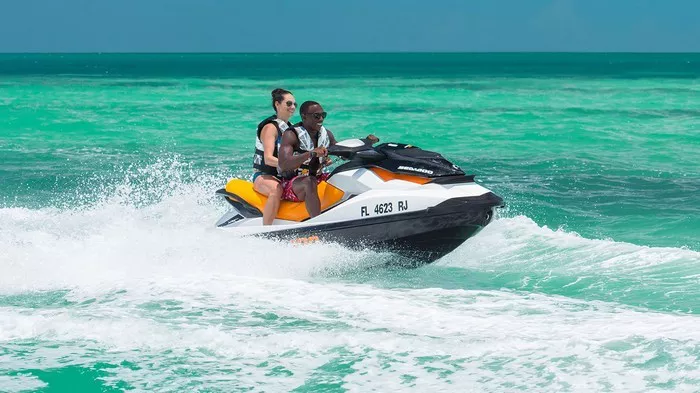Riding a Seadoo Jetski is an exhilarating experience that combines the thrill of speed with the joy of being on the water. Whether you’re a beginner or an experienced rider, understanding the basics and honing your skills can make your time on the Jetski more enjoyable and safe. This guide will take you through everything you need to know about riding a Seadoo Jetski, from preparation and safety measures to advanced riding techniques and maintenance tips.
Getting Started: Understanding Your Seadoo Jetski
Before you hit the water, it’s important to understand the components and controls of your Seadoo Jetski.
Familiarizing Yourself with the Jetski
- Hull: The body of the Jetski.
- Deck: The top surface where you stand or sit.
- Handlebars: Used for steering.
- Throttle Lever: Controls the speed.
- Start/Stop Button: Turns the engine on and off.
- Lanyard: A safety device that stops the engine if you fall off.
Safety Gear
- Life Jacket: Mandatory for all riders.
- Wetsuit: Provides protection and warmth.
- Gloves: Improve grip and protect hands.
- Footwear: Protects your feet from sharp objects.
- Helmet: Optional but recommended for high-speed riding.
Pre-Ride Checklist
- Fuel: Ensure the Jetski is fueled up.
- Oil Levels: Check and top up if necessary.
- Battery: Ensure it is fully charged.
- Inspection: Check for any visible damage or loose parts.
- Weather: Check the weather conditions.
Basic Riding Techniques
Now that you’re familiar with the Jetski and have all your gear, it’s time to learn the basics of riding.
Mounting the Jetski
- Place the Jetski in shallow water.
- Stand beside the Jetski, grab the handlebars, and step onto the deck.
- Sit down or stand up, depending on your preference.
Starting the Engine
- Attach the lanyard to your life jacket.
- Press the start button to turn on the engine.
- Allow the engine to warm up for a few minutes.
Steering and Throttle Control
- Steering: Use the handlebars to turn left or right.
- Throttle: Squeeze the throttle lever to accelerate. Release to decelerate.
Balancing on the Jetski
- Keep your knees slightly bent.
- Distribute your weight evenly.
- Use your body to help with steering.
Basic Maneuvers
- Straight Line: Keep the handlebars steady and apply even throttle.
- Turning: Lean into the turn and use the handlebars to steer.
- Stopping: Gradually release the throttle and let the Jetski coast to a stop.
Advanced Riding Techniques
Once you’re comfortable with the basics, you can start practicing more advanced techniques.
High-Speed Riding
- Throttle Control: Gradually increase the throttle to gain speed.
- Body Position: Lean forward to reduce wind resistance.
- Handling Waves: Use your knees as shock absorbers to handle choppy water.
Sharp Turns and Spins
- Sharp Turns: Lean your body into the turn and apply more throttle.
- 360 Spins: Shift your weight to the back of the Jetski and turn the handlebars sharply.
Jumping Waves
- Approach the wave at a moderate speed.
- Just before hitting the wave, increase the throttle.
- Keep your knees bent to absorb the impact.
Safety and Best Practices
Safety should always be your top priority when riding a Jetski.
General Safety Tips
- Always wear your safety gear.
- Be aware of your surroundings.
- Follow local waterway regulations.
- Avoid riding in bad weather or rough water.
Riding with Passengers
- Ensure the Jetski is rated for multiple passengers.
- Passengers should wear life jackets.
- Start at a slow speed and gradually increase as passengers get comfortable.
Navigating Busy Waterways
- Follow the right-hand rule.
- Use hand signals to communicate with other riders.
- Keep a safe distance from other watercraft.
Maintenance and Care
Proper maintenance ensures your Seadoo Jetski runs smoothly and lasts longer.
Regular Maintenance
- Engine Oil: Change as per the manufacturer’s recommendation.
- Battery: Keep it charged and check for corrosion.
- Hull: Clean after each use to remove salt and debris.
Seasonal Maintenance
- Winterization: Properly store your Jetski during the off-season.
- Inspection: Thoroughly inspect and repair any damage before the riding season.
Troubleshooting Common Issues
- Engine Problems: Check the fuel, oil levels, and spark plugs.
- Battery Issues: Ensure it is charged and connections are secure.
- Overheating: Check the cooling system and ensure there is no blockage.
See Also: What Is Discover Scuba Diving
Environmentally Responsible Riding
Respecting the environment is crucial while enjoying water sports.
Minimizing Impact
- Avoid riding in protected areas.
- Do not disturb wildlife.
- Follow local environmental regulations.
Fuel Efficiency
- Keep your Jetski well-maintained.
- Avoid excessive idling.
- Use eco-friendly fuel if available.
Conclusion
Riding a Seadoo Jetski is a fun and exciting activity that can be enjoyed by people of all ages. By following this comprehensive guide, you’ll be well-prepared to ride safely and confidently. Remember, practice makes perfect, and always prioritize safety while enjoying your time on the water.

